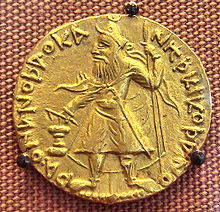พระเจ้ากนิษกะ
พระเจ้ากนิษกะที่ 1 (สันสกฤต: कनिष्क, Kaniṣka; กรีก-แบกเตรีย: Κανηϸκε Kanēške; ขโรษฐี: 𐨐𐨞𐨁𐨮𐨿𐨐 Ka-ṇi-ṣka;[4] พราหมี: ![]()
![]()
![]() Kā-ṇi-ṣka) กนิษกะ หรือ กนิษกะมหาราช[5] เป็นจักรพรรดิแห่งจักรวรรดิกุษาณะ ผู้ครองราชย์ในช่วงสูงสุดของกุษาณะ (ป. ค.ศ. 127–150)[6] พระองค์เป็นที่รู้จักจากผลงานทางการทัพ, การเมือง และทางศาสนา ทรงเป็นผู้สืบราชสกุลจากจักรพรรดิกุชุลา กัทผิเสส ปฐมกษัตริย์ของกุษาณะ ในรัชสมัยของพระเจ้ากนิษกะ จักรวรรดิกุษาณะมีพื้นที่ตั้งแต่เอเชียกลางและคันธาระ ไปถึงปาฏลีบุตรในที่ราบลุ่มแม่น้ำคงคา ราชธานีในรัชสมัยของพระองค์ตั้งอยู่ที่ปุรุษปุระ (ปัจจุบันคือเปศวาร์) ในคันธาระ และมีอีกราชธานีสำคัญอยู่ที่มถุรา มีการขุดพบเหรียญพระเจ้ากนิษกะที่ตริปุรี (ปัจจุบันคือชัพพัลปุระ)[7]
Kā-ṇi-ṣka) กนิษกะ หรือ กนิษกะมหาราช[5] เป็นจักรพรรดิแห่งจักรวรรดิกุษาณะ ผู้ครองราชย์ในช่วงสูงสุดของกุษาณะ (ป. ค.ศ. 127–150)[6] พระองค์เป็นที่รู้จักจากผลงานทางการทัพ, การเมือง และทางศาสนา ทรงเป็นผู้สืบราชสกุลจากจักรพรรดิกุชุลา กัทผิเสส ปฐมกษัตริย์ของกุษาณะ ในรัชสมัยของพระเจ้ากนิษกะ จักรวรรดิกุษาณะมีพื้นที่ตั้งแต่เอเชียกลางและคันธาระ ไปถึงปาฏลีบุตรในที่ราบลุ่มแม่น้ำคงคา ราชธานีในรัชสมัยของพระองค์ตั้งอยู่ที่ปุรุษปุระ (ปัจจุบันคือเปศวาร์) ในคันธาระ และมีอีกราชธานีสำคัญอยู่ที่มถุรา มีการขุดพบเหรียญพระเจ้ากนิษกะที่ตริปุรี (ปัจจุบันคือชัพพัลปุระ)[7]
| กนิษกะ | |
|---|---|
| กษัตริย์แห่งกุษาณ | |
 เหรียญทองพระเจ้ากนิษกะ สลักด้วยภาษากรีก-แบกเตรียว่า: ϷΑΟΝΑΝΟϷΑΟ ΚΑΝΗϷΚΙ ΚΟϷΑΝΟ Shaonanoshao Kanishki Koshano "กษัตริย์แห่งกษัตริย์ทั้งปวง - กนิษกะแห่งกุษาณะ" พิพิธภัณฑ์บริติช | |
| ครองราชย์ | คริสต์ศตวรรษที่ 2 (ประมาณ ค.ศ. 127–150) |
| ก่อนหน้า | วีมะ กัทผิเสส |
| ถัดไป | หุวิษกะ |
| ประสูติ | น่าจะKhotan,[1][2][3] กัศมีร์[3] |
| ราชวงศ์ | กุษาณะ |
| ศาสนา | พุทธ |
การพิชิตดินแดนต่าง ๆ และการอุปถัมภ์ศาสนาพุทธของพระองค์มีส่วนสำคัญมากในการพัฒนาของเส้นทางสายไหมและการเผยแผ่พุทธศาสนานิกายมหายานจากคันธาระ การาโกรัม ไปจนถึงจีน ในราว ค.ศ. 127 พระองค์เปลี่ยนภาษาราชการของจักรวรรดิจากภาษากรีกเป็นภาษาแบกเตรีย[8]
นักวิชาการยุคแรกเชื่อว่ากนิษกะขึ้นครองราชย์ใน ค.ศ. 78 และถือเป็นปีที่เป็นจุดเริ่มต้นของมหาศักราช อย่างไรก็ตาม นักประวัติศาสตร์ไม่ถือว่าปีนี้เป็นปีขึ้นครองราชย์ของพระองค์ Falk ประมาณการว่ากนิษกะขึ้นครองราชย์ใน ค.ศ. 127[9]
ลำดับวงศ์ตระกูล แก้
Mahārāja Rājadhirāja Devaputra Kāṇiṣka
"มหาราช ราชาธิราช เทวบุตร กนิษกะ"[10]
ศิลปะมถุรา พิพิธภัณฑ์มถุรา
มีทฤษฎีเกี่ยวกับต้นกำเนิดของกนิษกะอยู่สองแบบ ซึ่งทั้งสองอิงจากสันนิษฐานของราชวงศ์กนิษกะที่แยกจากกัน[3] ทฤษฎีของ Sten Konow ระบุว่ากนิษกะมาจาก Khotan โดยถูกเรียกตัวเป็นพันธมิตรทางชาติพันธุ์ในช่วงเวลาที่มีปัญหาหลังรัชสมัยวีมะ[3] Konow สนับสนุนทฤษฎีนี้ด้วยการอ้างอิงธรรมเนียมทิเบตว่าการขยายไปอินเดียของชาว Khotan ประมาณ ค.ศ. 120 ได้รับการบัญชาจากกษัตริย์ Vijayakirti ร่วมกับกษัตริย์ Kanika และกษัตริย์ Guzan[11][12]
ทฤษฎีที่คล้ายกันของ Roman Ghirshman ระบุว่า เดิมทีกนิษกะเป็นกษัตริย์แห่งกัศมีร์ก่อนมีอำนาจเป็นราชวงศ์ใหม่[3] เขาอ้างอิงคำจารึกที่ Khalatse ซึ่งอาจหมายถึงอำนาจของกุษาณะที่แผ่ขยายไปถึงมุมตะวันออกเฉียงเหนือของกัศมีร์และ Rajatarangini ด้วย ซึ่งรายพระนามกษัตริย์ Turushka แห่งกัศมีร์ระบุกนิษกะเป็นลำดับที่สาม ร่ามกับพระนาม Hushka และ Jushka[3]ท้ายที่สุด คำให้การเกี่ยวกับกิจกรรมของพระเจ้ากนิษกะในกัศมีร์เพื่อสนับสนุนศาสนาพุทธศาสนาเสนอแนะว่าพระองค์โปรดปรานภูมิภาคนี้เหนือภูมิภาคอื่น ๆ และพระองค์สถาปนาเปศวาร์เป็นเมืองหลวงที่ใกล้กัศมีร์[3]
พระองค์มีเชื้อสายเยฺว่จือและภาษาแม่ของพระองค์อาจเป็นภาษาโทแคเรียน[13]
อ้างอิง แก้
- ↑ Gakkai, Soka (2009-01-01). Dictionary of Buddhism (ภาษาอังกฤษ). Motilal Banarsidass. p. 328. ISBN 978-81-208-3334-0.
According to one influential account, he was born in Khotan and came from a family line different from that of Kushan dynasty founder Kujūla Kadphises and his successor, Vīma Kadphises.
- ↑ Daniélou, Alain (2003-02-11). A Brief History of India (ภาษาอังกฤษ). Simon and Schuster. p. 109. ISBN 978-1-59477-794-3.
According to the Chinese sources, Kanishka came originally from Khotan and belonged to one of the smaller Yueh Chi tribes.
- ↑ 3.0 3.1 3.2 3.3 3.4 3.5 3.6 Rosenfield, John M. (1967). The Dynasty Arts of the Kushans (ภาษาอังกฤษ). University of California Press. pp. 40–41.
There are two unconfirmed theories about Kanisha's having ruled in the periphery of the Kushan Empire before assuming power as the Shaonanoshao. Both are based on the supposition of a separate Kanishka dynasty. The earlier-Sten Konow's-is that Kanishka came from Khotan, having been summoned as an ethnic ally at the time of troubles after Vima's reign. Konow supports this theory by citing a Tibetan tradition that a Khotanese expedition to India of about A.D. 120 was commanded by a King Vijayakirti along with a King Kanika and the king of Guzan. Ghirshman's similar theory is that Kanishka was originally king of Kashmir before becoming suzerain of the dynasty as a whole. He cites the above mentioned Khalatse epigraph, which may allude to Kushan power reaching the northeast corner of Kashmir, and also the Rajatarangini, in which the list of Turushka kings of Kashmir gave Kanishka's name as the third of a sequence, suggesting that he had predecessors there (Hushka and Jushka). Finally, testimony of Kanishka's activity in Kashmir in favor of the Buddhist faith suggests that he favored the region above others and that he founded Peshawar as his capital to be close to Kashmir.
- ↑ B.N. Mukhjerjee, Shāh-jī-kī-ḍherī Casket Inscription, The British Museum Quarterly, Vol. 28, No. 1/2 (Summer, 1964), pp. 39–46
- ↑ "The yuga of Sphujiddhvaja and the era of the Kuṣâṇas." Harry Falk. Silk Road Art and Archaeology VII.
- ↑ Bracey, Robert (2017). "The Date of Kanishka since 1960 (Indian Historical Review, 2017, 44(1), 1-41)". Indian Historical Review (ภาษาอังกฤษ). 44: 1–41.
- ↑ Dahiya, Poonam Dalal (2017-09-15). ANCIENT AND MEDIEVAL INDIA EBOOK (ภาษาอังกฤษ). McGraw-Hill Education. pp. 278–281. ISBN 978-93-5260-673-3.
- ↑ The Kushans at first retained the Greek language for administrative purposes but soon began to use Bactrian. The Bactrian Rabatak inscription (discovered in 1993 and deciphered in 2000) records that the Kushan king Kanishka the Great (ป. 127 AD), discarded Greek (Ionian) as the language of administration and adopted Bactrian ("Arya language"), from Falk (2001): "The yuga of Sphujiddhvaja and the era of the Kuṣâṇas." Harry Falk. Silk Road Art and Archaeology VII, p. 133.
- ↑ Falk (2001), pp. 121–136. Falk (2004), pp. 167–176
- ↑ Puri, Baij Nath (1965). India under the Kushāṇas (ภาษาอังกฤษ). Bharatiya Vidya Bhavan.
- ↑ Gakkai, Soka (2009-01-01). Dictionary of Buddhism (ภาษาอังกฤษ). Motilal Banarsidass. p. 328. ISBN 978-81-208-3334-0.
According to one influential account, he was born in Khotan and came from a family line different from that of Kushan dynasty founder Kujūla Kadphises and his successor, Vīma Kadphises.
- ↑ Daniélou, Alain (2003-02-11). A Brief History of India (ภาษาอังกฤษ). Simon and Schuster. p. 109. ISBN 978-1-59477-794-3.
According to the Chinese sources, Kanishka came originally from Khotan and belonged to one of the smaller Yueh Chi tribes.
- ↑ Findeisen, Raoul David; Isay, Gad C.; Katz-Goehr, Amira (2009). At Home in Many Worlds: Reading, Writing and Translating from Chinese and Jewish Cultures : Essays in Honour of Irene Eber (ภาษาอังกฤษ). Otto Harrassowitz Verlag. p. 138. ISBN 978-3-447-06135-3.
ข้อมูล แก้
- Falk, Harry (2001): "The yuga of Sphujiddhvaja and the era of the Kuṣâṇas." In: Silk Road Art and Archaeology VII, pp. 121–136.
- Falk, Harry (2004): "The Kaniṣka era in Gupta records." In: Silk Road Art and Archaeology X (2004), pp. 167–176.
แหล่งข้อมูลอื่น แก้
- วิกิมีเดียคอมมอนส์มีสื่อเกี่ยวกับ Kanishka I